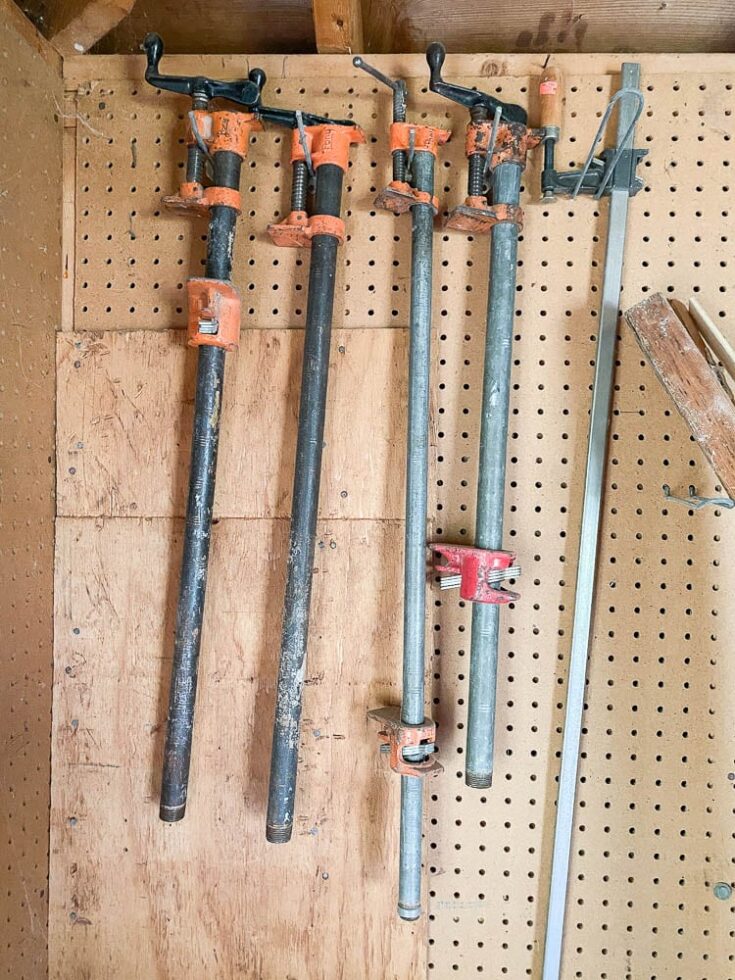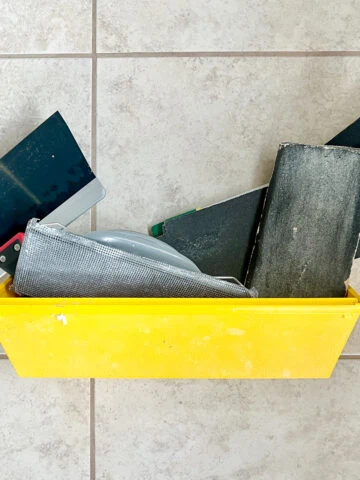Large wood clamps are great for woodworking projects. Learn how to build pipe clamps for almost any size wood project in this tutorial.

Our backstory on getting started with woodworking
12+ years ago, as we were starting our renovation journey, I had no idea what type of wooden clamps to buy for projects. We had some spring clamps in our tool collection but those had mainly been used for hanging sheeting for when we used our paint sprayer or holding edging on to the end of wood pieces.
After a trip to the hardware store, I came home with a couple ratcheting c-clamps. At around $20 though, and for only a set distance amount, I quickly realized that we still didn't have the right type of tool. We needed large woodworking clamps and what we owned didn't cut it.
I honestly had no idea that pipe clamps were a thing at this point though so we just kept doing projects without having the right set of clamps for them. One day, at my Grandpa's workshop, I was looking around and helping him with something (oh, I think it was when he helped me strengthen and fix wobbly chairs!). Anyways, he had a bunch of pipe clamps for wood.
I asked him about them and he said that the adjustable pipe clamps are great and he uses them all the time. After seeing his collection, I set out to make some of my own.
Affiliate links below. Thanks for supporting my blog. Click to ready my privacy and disclosure policy.
Supplies Needed to Assemble Your Own Pipe Clamps
- ¾" Pipe Clamp* or
- ½" Pipe Clamp
- Corresponding threaded galvanized pipe for size of pipe clamp you purchased
The pony clamps will come in two pieces (a clamp and a spreader). Half of the pony clamp that you buy is going to look like this:

The other side (the spreader) is going to look like this (but won't be on a pipe at this point):

I'm hesitant to call this "DIY" pipe clamps because it's really just buying two parts and putting them together. But, since I didn't know about these when I started my woodworking journey, I'm sharing about how to make these clamps for woodworking.
How to Make Pipe Clamps
To build your wood clamps, place the spreader and the pony clamp on your threaded galvanized pipe at opposite ends. One part of the pipe clamp will be stationary and the other part of the pipe clamp will allow you to move it to hold wood in place.
You can make these woodworking clamps at different sizes. To do this, you just need to cut your pipe at different lengths. In my grandfather's workshop, he had probably thirty pipe clamps and most of them were on pipes that were ½" thick and were around 3-5' long.
What is the total cost to make cheap pipe clamps?
A pipe that's around 3' will run you around $20. Pipe clamps are normally just under $20. So, one pipe clamp will run you right under $40.
What type of pipe is used for pipe clamps?
Usually threaded galvanized pipes in ½" or ¾" are used.

One way to save money would be to thread your own pipes. If you have a pipe threader this can be a great option as you can find pipes often at garage sales, restores, etc., pretty often.
We borrowed a pipe threader a few years' ago from my dad when we were working on customizing our living room light. It was a fun tool to use. A small learning curve, but definitely doable for sure.

Well, I hope this was helpful to hear about! We've slowly added to our woodworking clamps. I've found a few bar clamps at garage sales and picked up a few C clamps up at the hardware store. The more woodworking you end up doing, the more you'll need.
If you are interested in trying your hand at an entry-level woodworking project, I still love these two projects that I did:
How to Make Pipe Clamps (DIY Wood Clamps)

Large wood clamps are great for woodworking projects. Learn how to build pipe clamps for almost any size wood project in this tutorial.
Materials
- ¾ Pipe Clamp and Spreader or
- ½ Pipe Clamp and Spreader
- *Corresponding threaded galvanized pipe for the size of the pipe clamp you purchased
Instructions
- To build your wood clamps, place the spreader and the pony clamp on your threaded galvanized pipe at opposite ends.
- One part of the pipe clamp will be stationary and the other part of the pipe clamp will allow you to move it to hold wood in place.
Notes
You can make these woodworking clamps at different sizes. To do this, you just need to cut your pipe at different lengths. In my grandfather’s workshop, he had probably thirty pipe clamps and most of them were on pipes that were ½″ thick and were around 3-5′ long.







William
This article is much too long for such a simple topic. Please don't waste my attention on explaining things that are so obvious, like 'How to use a screwdriver."
Ric Meagley
William, dude! Did she send you a special invitation to read this article? You're the one who kept reading after the first few sentences. If you knew a small fraction of what any veteran woodworker knows, you would have already known this short lil article wouldn't be worth your precious time, before even clicking on the title. There's really nothing good or productive about projecting your own insecurities on others. Especially someone who simply wanted to share their own experiences with others. I think for myself and know what i know. How about you?
Ric Meagley
Not actually a DIY clamp, like a moxon vice might be, for example. The parts are sold in stores specifically for the purpose of doing what you just described here. But of course you already said that lol
Anyhoot..... another simple yet great "trick" we can do with pipe clamps is to buy some galvanized threaded pipe couplers to fit the pipe size we're using. With a coupler, we can take two 4' pipe clamps and quickly convert them to one 8' clamp. Of course we can make any length we want now by combining as many pipes as you need. Also, pipe clamps are reportedly the strongest of woodworking clamps, delivering a half ton psi each. Been my goto for many projects through the decades. Thanks for sharing this with people that need it. Most of us veteran woodworkers take those simple things for granted and thereby never bother to share them.
Christopher
As a person that does woodwork and plumbing, I found this article interesting and helpful. Thank you.
Me
Assembling v. "building"